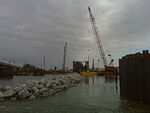Wesley Barrow Stadium

Wesley Barrow Stadium is a 650-seat baseball and softball stadium located in the Pontchartrain Park section of New Orleans, Louisiana. Named in memory of Negro league baseball manager Wesley Barrow, a longtime prominent figure in the New Orleans baseball community, the stadium includes a 200-square-foot climate-controlled press box, a public address system and LED scoreboard. The baseball field features professional-sized artificial turf with a clay pitcher's mound and two fenced bullpens.The facility also includes grass tee-ball fields, a three-lane outdoor batting practice cage and a two-lane indoor batting practice building. It also includes administration facilities and two 300-square-foot conference rooms.It is the current site of the Major League Baseball Urban Youth Academy in New Orleans. The academy will provide free, year-round baseball and softball instruction and other educational services for youth from underserved and urban communities throughout southern Louisiana.
Excerpt from the Wikipedia article Wesley Barrow Stadium (License: CC BY-SA 3.0, Authors, Images).Wesley Barrow Stadium
Hayne Boulevard, New Orleans Gentilly
Geographical coordinates (GPS) Address External links Nearby Places Show on map
Geographical coordinates (GPS)
| Latitude | Longitude |
|---|---|
| N 30.02836 ° | E -90.04268 ° |
Address
Barrow Stadium
Hayne Boulevard
70126 New Orleans, Gentilly
Louisiana, United States
Open on Google Maps









